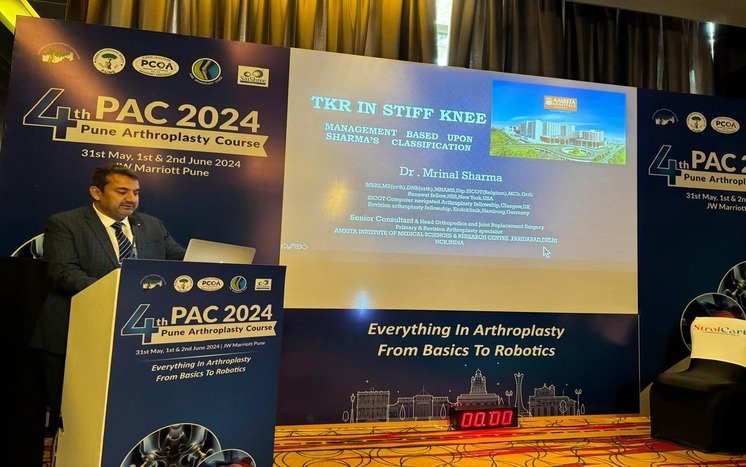
10:00am to 04:00pm (Mon to Sat) - Metro Hospital, Faridabad
06:00pm to 08:00pm (Mon to Sat) - Arthrocare Clinic, Noida
10:00am to 04:00pm (Mon to Sat) - Metro Hospital, Faridabad
06:00pm to 08:00pm (Mon to Sat) - Arthrocare Clinic, Noida
 November 20, 2023
November 20, 2023
Joint replacement surgery has become a transformative solution for individuals grappling with debilitating joint conditions. Despite its proven success in restoring mobility and alleviating pain, various myths and misconceptions surround joint replacement. In this comprehensive exploration, we will debunk these myths, providing factual insights into the world of joint replacement surgery.
Myth 1: Joint Replacement is Only for the Elderly
One prevalent myth is that joint replacement is exclusively reserved for older people. In reality, joint conditions can affect individuals of all ages, and joint replacement surgery is recommended based on the severity of the condition rather than age. Younger adults experiencing conditions like rheumatoid arthritis or joint injuries may also benefit from joint replacement.
Myth 2: Joint Replacement is Always a Last Resort
Contrary to popular belief, joint replacement is not always the last resort. While conservative treatments such as medications, physical therapy, and lifestyle modifications are often recommended initially, joint replacement may be considered earlier if these interventions prove ineffective. Early intervention can prevent further joint damage and improve overall outcomes.
Myth 3: Recovery Takes a Long Time, and Results are Temporary
Another misconception is that the recovery from joint replacement is arduous, and the results are short-lived. In reality, surgical techniques and rehabilitation advancements have significantly shortened recovery times. Many patients experience relief from pain and improved mobility within weeks or months after surgery, with long-lasting results that enhance their quality of life for years.
Myth 4: Joint Replacement is Only for Severe Pain
While severe pain is a common indication for joint replacement, it’s not the sole criterion. Functional limitations, reduced quality of life, and the inability to perform daily activities are equally important factors. Joint replacement aims to restore pain-free movement, overall function, and mobility.
Myth 5: All Joint Replacements are the Same
There is a misconception that all joint replacements are identical. In reality, joint replacement surgeries are highly personalized. Different joints, such as knees, hips, shoulders, and elbows, have unique anatomical considerations, and the choice of implants and surgical techniques varies accordingly. Each patient’s treatment plan is tailored to their specific needs and condition.
Myth 6: You Can’t Be Active After Joint Replacement
Some believe that after joint replacement, individuals must lead a sedentary lifestyle. The truth is that joint replacement is intended to facilitate an active and pain-free life. While high-impact activities may need modification, patients are encouraged to engage in low-impact exercises and activities to maintain joint health and overall well-being.
Myth 7: Joint Replacement is Risky and Complicated
While no surgery is entirely without risks, joint replacement procedures have become routine and highly successful. Advances in surgical techniques, anesthesia, and postoperative care have significantly reduced the risks associated with joint replacement. The majority of patients undergo joint replacement without complications and achieve positive outcomes.
Myth 8: You Have to Wait Until the Pain is Unbearable
Delaying joint replacement until the pain becomes unbearable is a common misconception. Early intervention can prevent irreversible joint damage, making the surgery more effective and increasing the likelihood of a quicker recovery. Consulting with an orthopedic specialist at the onset of joint issues allows for a comprehensive evaluation and timely intervention.
Myth 9: Joint Replacement is Only for Arthritis
While arthritis is a prevalent reason for joint replacement, it’s not the sole condition that warrants the surgery. Joint replacement can also benefit individuals with joint injuries, congenital disorders, or other degenerative conditions affecting joint function.
Myth 10: Joint Replacement is the Same for Everyone
Joint replacement surgeries are highly individualized. Factors such as age, overall health, lifestyle, and the specific joint being replaced influence the surgical approach and choice of implants. The orthopedic surgeon collaborates with each patient to create a personalized treatment plan tailored to their unique circumstances.
Common Questions about Joint Replacement:
What are the 2 most common types of joint replacement?
The two most common types of joint replacement are Total Knee Replacement (TKR) and Total Hip Replacement (THR). These procedures involve replacing a damaged knee or hip joint with an artificial implant, relieving pain, and restoring function.
What are the problems with joint replacement?
Common problems associated with joint replacement can include infection, loosening of the implant, instability, wear and tear, and, in rare cases, implant failure. However, advancements in surgical techniques and materials have significantly reduced the occurrence of these issues.
What are common reasons for joint replacement?
Common reasons for joint replacement include osteoarthritis, rheumatoid arthritis, joint injuries, congenital disorders, and other degenerative conditions affecting joint function. Joint replacement is considered when conservative treatments fail to provide relief, and the individual’s quality of life is significantly impacted.
Conclusion: Dispelling the Myths, Embracing the Facts
Joint replacement surgery has emerged as a transformative solution for individuals seeking relief from debilitating joint conditions. By dispelling common myths and providing accurate information, it becomes evident that joint replacement is a versatile and effective intervention that can enhance the quality of life for individuals across various age groups. As technology and medical practices evolve, joint replacement will likely become even more accessible, efficient, and tailored to individual needs, debunking myths and empowering individuals to make informed decisions about their joint health. If you or someone you know is considering joint replacement, consult an orthopedic specialist to explore personalized options and embark on a journey to improved mobility and well-being.
Consult now for more clarity on Joint replacement with Dr. Mrinal Sharma – the best orthopedic doctor. Call now for book an appointment:- +91 99109 69298




